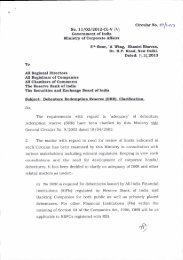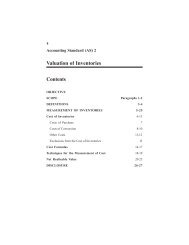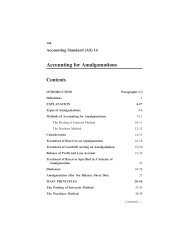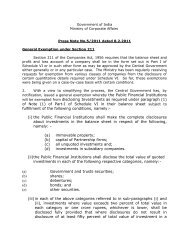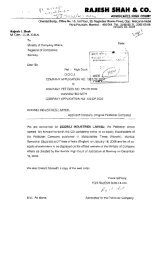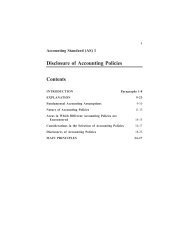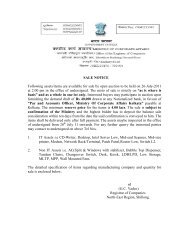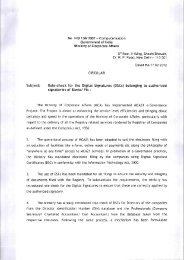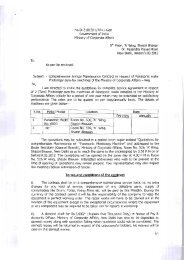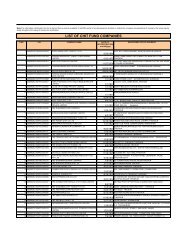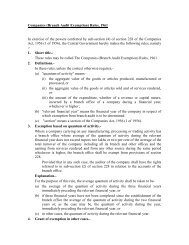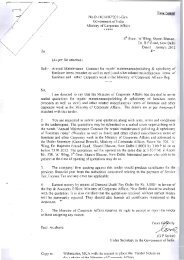Cash Flow Statements Contents
Cash Flow Statements Contents
Cash Flow Statements Contents
You also want an ePaper? Increase the reach of your titles
YUMPU automatically turns print PDFs into web optimized ePapers that Google loves.
16<br />
Accounting Standard (AS) 3<br />
<strong>Cash</strong> <strong>Flow</strong> <strong>Statements</strong><br />
<strong>Contents</strong><br />
OBJECTIVE<br />
SCOPE Paragraphs 1-2<br />
BENEFITS OF CASH FLOW INFORMATION 3-4<br />
DEFINITIONS 5-7<br />
<strong>Cash</strong> and <strong>Cash</strong> Equivalents 6-7<br />
PRESENTATION OF A CASH FLOW STATEMENT 8-17<br />
Operating Activities 11-14<br />
Investing Activities 15-16<br />
Financing Activities 17<br />
REPORTING CASH FLOWS FROM OPERATING<br />
ACTIVITIES 18-20<br />
REPORTING CASH FLOWS FROM INVESTING AND<br />
FINANCING ACTIVITIES 2 1<br />
REPORTING CASH FLOWS ON A NET BASIS 22-24<br />
FOREIGN CURRENCY CASH FLOWS 25-27<br />
EXTRAORDINARY ITEMS 28-29<br />
INTEREST AND DIVIDENDS 30-33<br />
TAXES ON INCOME 34-35<br />
Continued../..
INVESTMENTS IN SUBSIDIARIES, ASSOCIATES AND<br />
JOINT VENTURES 3 6<br />
ACQUISITIONS AND DISPOSALS OF SUBSIDIARIES<br />
AND OTHER BUSINESS UNITS 37-39<br />
NON-CASH TRANSACTIONS 40-41<br />
COMPONENTS OF CASH AND CASH EQUIVALENTS 42-44<br />
OTHER DISCLOSURES 45-48<br />
ILLUSTRATIONS<br />
17
Accounting Standard (AS) 3<br />
<strong>Cash</strong> <strong>Flow</strong> <strong>Statements</strong><br />
<strong>Cash</strong> <strong>Flow</strong> <strong>Statements</strong> 53<br />
(This Accounting Standard includes paragraphs set in bold italic type<br />
and plain type, which have equal authority. Paragraphs in bold italic<br />
type indicate the main principles. This Accounting Standard should be<br />
read in the context of its objective and the General Instructions<br />
contained in part A of the Annexure to the Notification.)<br />
This Accounting Standard is not mandatoryfor Small and Medium Sized<br />
Companies, as defined in the Notification. Such companies are however<br />
encouraged to comply with the Standard.<br />
Objective<br />
Information about the cash flows of an enterprise is useful in providing users<br />
of financial statements with a basis to assess the ability of the enterprise<br />
to generate cash and cash equivalents and the needs of the enterprise to<br />
utilise those cash flows. The economic decisions that are taken by users<br />
require an evaluation of the ability of an enterprise to generate cash and<br />
cash equivalents and the timing and certainty of their generation.<br />
The Standard deals with the provision of information about the historical<br />
changes in cash and cash equivalents of an enterprise by means of a cash<br />
flow statement which classifies cash flows during the period from operating,<br />
investing and financing activities.<br />
Scope<br />
1. An enterprise should prepare a cash flow statement and should<br />
present it for each period for which financial statements are presented.<br />
2. Users of an enterprise’s financial statements are interested in how the<br />
enterprise generates and uses cash and cash equivalents. This is the case<br />
regardless of the nature of the enterprise’s activities and irrespective of<br />
whether cash can be viewed as the product of the enterprise, as may be the<br />
case with a financial enterprise. Enterprises need cash for essentially the<br />
same reasons, however different their principal revenue-producing activities<br />
might be. They need cash to conduct their operations, to pay their obligations,<br />
and to provide returns to their investors.
Benefits of <strong>Cash</strong> <strong>Flow</strong> Information<br />
<strong>Cash</strong> <strong>Flow</strong> <strong>Statements</strong> 19<br />
3. A cash flow statement, when used in conjunction with the other financial<br />
statements, provides information that enables users to evaluate the changes<br />
in net assets of an enterprise, its financial structure (including its liquidity and<br />
solvency) and its ability to affect the amounts and timing of cash flows in<br />
order to adapt to changing circumstances and opportunities. <strong>Cash</strong> flow<br />
information is useful in assessing the ability of the enterprise to generate<br />
cash and cash equivalents and enables users to develop models to assess<br />
and compare the present value of the future cash flows of different<br />
enterprises. It also enhances the comparability of the reporting of operating<br />
performance by different enterprises because it eliminates the effects of<br />
using different accounting treatments for the same transactions and events.<br />
4. Historical cash flow information is often used as an indicator of the<br />
amount, timing and certainty of future cash flows. It is also useful in checking<br />
the accuracy of past assessments of future cash flows and in examining the<br />
relationship between profitability and net cash flow and the impact of<br />
changing prices.<br />
Definitions<br />
5. The following terms are used in this Standard with the meanings<br />
specified:<br />
5.1 <strong>Cash</strong> comprises cash on hand and demand deposits with banks.<br />
5.2 <strong>Cash</strong> equivalents are short term, highly liquid investments that<br />
are readily convertible into known amounts of cash and which are<br />
subject to an insignificant risk of changes in value.<br />
5.3 <strong>Cash</strong> flows are inflows and outflows of cash and cash equivalents.<br />
5.4 Operating activities are the principal revenue-producing activities<br />
of the enterprise and other activities that are not investing or<br />
financing activities.<br />
5.5 Investing activities are the acquisition and disposal of long-term<br />
assets and other investments not included in cash equivalents.<br />
5.6 Financing activities are activities that result in changes in the size<br />
and composition of the owners’ capital (including preference share<br />
capital in the case of a company) and borrowings of the enterprise.
20 AS 3<br />
<strong>Cash</strong> and <strong>Cash</strong> Equivalents<br />
6. <strong>Cash</strong> equivalents are held for the purpose of meeting short-term cash<br />
commitments rather than for investment or other purposes. For an investment<br />
to qualify as a cash equivalent, it must be readily convertible to a known<br />
amount of cash and be subject to an insignificant risk of changes in value.<br />
Therefore, an investment normally qualifies as a cash equivalent only when<br />
it has a short maturity of, say, three months or less from the date of acquisition.<br />
Investments in shares are excluded from cash equivalents unless they are, in<br />
substance, cash equivalents; for example, preference shares of a company<br />
acquired shortly before their specified redemption date (provided there is<br />
only an insignificant risk of failure of the company to repay the amount at<br />
maturity).<br />
7. <strong>Cash</strong> flows exclude movements between items that constitute cash or<br />
cash equivalents because these components are part of the cash management<br />
of an enterprise rather than part of its operating, investing and financing<br />
activities. <strong>Cash</strong> management includes the investment of excess cash in cash<br />
equivalents.<br />
Presentation of a <strong>Cash</strong> <strong>Flow</strong> Statement<br />
8. The cash flow statement should report cash flows during the period<br />
classified by operating, investing and financing activities.<br />
9. An enterprise presents its cash flows from operating, investing and<br />
financing activities in a manner which is most appropriate to its business.<br />
Classification by activity provides information that allows users to assess the<br />
impact of those activities on the financial position of the enterprise and the<br />
amount of its cash and cash equivalents. This information may also be used<br />
to evaluate the relationships among those activities.<br />
10. A single transaction may include cash flows that are classified<br />
differently. For example, when the instalment paid in respect of a fixed asset<br />
acquired on deferred payment basis includes both interest and loan, the interest<br />
element is classified under financing activities and the loan element is<br />
classified under investing activities.<br />
Operating Activities<br />
11. The amount of cash flows arising from operating activities is a key<br />
indicator of the extent to which the operations of the enterprise have generated<br />
sufficient cash flows to maintain the operating capability of the enterprise,
<strong>Cash</strong> <strong>Flow</strong> <strong>Statements</strong> 21<br />
pay dividends, repay loans and make new investments without recourse to<br />
external sources of financing. Information about the specific components of<br />
historical operating cash flows is useful, in conjunction with other information,<br />
in forecasting future operating cash flows.<br />
12. <strong>Cash</strong> flows from operating activities are primarily derived from the<br />
principal revenue-producing activities of the enterprise. Therefore,<br />
they generally result from the transactions and other events that enter<br />
into the determination of net profit or loss. Examples of cash flows from<br />
operating activities are:<br />
(a) cash receipts from the sale of goods and the rendering of services;<br />
(b) cash receipts from royalties, fees, commissions and other revenue;<br />
(c) cash payments to suppliers for goods and services;<br />
(d) cash payments to and on behalf of employees;<br />
(e) cash receipts and cash payments of an insurance enterprise for<br />
premiums and claims, annuities and other policy benefits;<br />
(f) cash payments or refunds of income taxes unless they can be<br />
specifically identified with financing and investing activities; and<br />
(g) cash receipts and payments relating to futures contracts, forward<br />
contracts, option contracts and swap contracts when the contracts<br />
are held for dealing or trading purposes.<br />
13. Some transactions, such as the sale of an item of plant, may give rise to<br />
a gain or loss which is included in the determination of net profit or loss.<br />
However, the cash flows relating to such transactions are cash flows from<br />
investing activities.<br />
14. An enterprise may hold securities and loans for dealing or trading<br />
purposes, in which case they are similar to inventory acquired specifically<br />
for resale. Therefore, cash flows arising from the purchase and sale of dealing<br />
or trading securities are classified as operating activities. Similarly, cash<br />
advances and loans made by financial enterprises are usually classified as<br />
operating activities since they relate to the main revenue-producing activity<br />
of that enterprise.<br />
Investing Activities<br />
15. The separate disclosure of cash flows arising from investing activities
22 AS 3<br />
is important because the cash flows represent the extent to which expenditures<br />
have been made for resources intended to generate future income and cash<br />
flows. Examples of cash flows arising from investing activities are:<br />
(a) cash payments to acquire fixed assets (including intangibles).<br />
These payments include those relating to capitalised research and<br />
development costs and self-constructed fixed assets;<br />
(b) cash receipts from disposal of fixed assets (including intangibles);<br />
(c) cash payments to acquireshares,warrantsor debt instruments of<br />
other enterprises and interests in joint ventures (other than<br />
payments for those instruments considered to be cash equivalents<br />
and those held for dealing or trading purposes);<br />
(d) cash receipts from disposal of shares, warrants or debt instruments<br />
of other enterprises and interests in joint ventures (other than<br />
receipts from those instruments considered to be cash equivalents<br />
and those held for dealing or trading purposes);<br />
(e) cash advances and loans made to third parties (other than<br />
advances and loans made by a financial enterprise);<br />
(f) cash receipts from the repayment of advances and loans made to<br />
third parties (other than advances and loans of a financial<br />
enterprise);<br />
(g) cash payments for futures contracts, forward contracts, option<br />
contracts and swap contracts except when the contracts are held<br />
for dealing or trading purposes, or the payments are classified as<br />
financing activities; and<br />
(h) cash receipts from futures contracts, forward contracts, option<br />
contracts and swap contracts except when the contracts are held<br />
for dealing or trading purposes, or the receipts are classified as<br />
financing activities.<br />
16. When a contract is accounted for as a hedge of an identifiable position,<br />
the cash flows of the contract are classified in the same manner as the cash<br />
flows of the position being hedged.
Financing Activities<br />
<strong>Cash</strong> <strong>Flow</strong> <strong>Statements</strong> 23<br />
17. The separate disclosure of cash flows arising from financing activities<br />
is important because it is useful in predicting claims on future cash flows by<br />
providers of funds (both capital and borrowings) to the enterprise. Examples<br />
of cash flows arising from financing activities are:<br />
(a) cash proceeds from issuing shares or other similar instruments;<br />
(b) cash proceeds from issuing debentures, loans, notes, bonds, and<br />
other short or long-term borrowings; and<br />
(c) cash repayments of amounts borrowed.<br />
Reporting <strong>Cash</strong> <strong>Flow</strong>sfromOperating Activities<br />
18. An enterprise should report cash flows from operating activities<br />
using either:<br />
(a) the direct method, whereby major classes of gross cash receipts<br />
and gross cash payments are disclosed; or<br />
(b) the indirect method, whereby net profit or loss is adjusted for<br />
the effects of transactions of a non-cash nature, any deferrals<br />
or accruals of past or future operating cash receipts or<br />
payments, and items of income or expense associated with<br />
investing or financing cash flows.<br />
19. The direct method provides information which may be useful in<br />
estimating future cash flows and which is not available under the indirect<br />
method and is, therefore, considered more appropriate than the indirect<br />
method. Under the direct method, information about major classes of gross<br />
cash receipts and gross cash payments may be obtained either:<br />
(a) from the accounting records of the enterprise; or<br />
(b) by adjusting sales, cost of sales (interest and similar income and<br />
interest expense and similar charges for a financial enterprise)<br />
and other items in the statement of profit and loss for:<br />
i) changes during the period in inventories and operating<br />
receivables and payables;
24 AS 3<br />
ii) other non-cash items; and<br />
iii) other items for which the cash effects are investing or<br />
financing cash flows.<br />
20. Under the indirect method, the net cash flow from operating activities<br />
is determined by adjusting net profit or loss for the effects of:<br />
(a) changes during the period in inventories and operating receivables<br />
and payables;<br />
(b) non-cash items such as depreciation, provisions, deferred taxes,<br />
and unrealised foreignexchange gains and losses; and<br />
(c) all other itemsfor which the cash effects areinvestingor financing<br />
cash flows.<br />
Alternatively, the net cash flow from operating activities may be presented<br />
under the indirect method by showing the operating revenues and expenses<br />
excluding non-cash items disclosed in the statement of profit and loss and<br />
the changes during the period in inventories and operating receivables and<br />
payables.<br />
Reporting <strong>Cash</strong> <strong>Flow</strong>sfromInvesting andFinancing<br />
Activities<br />
21. An enterprise should report separately major classes of gross cash<br />
receipts and gross cash payments arising from investing and financing<br />
activities, except to the extent that cash flows described in paragraphs<br />
22 and 24 are reported on a net basis.<br />
Reporting <strong>Cash</strong> <strong>Flow</strong>s on a Net Basis<br />
22. <strong>Cash</strong> flows arising from the following operating, investing or<br />
financing activities may be reported on a net basis:<br />
(a) cash receipts and payments onbehalf of customers when the<br />
cash flows reflect the activities of the customer rather than<br />
those of the enterprise; and
<strong>Cash</strong> <strong>Flow</strong> <strong>Statements</strong> 25<br />
(b) cash receipts and payments for items in which the turnover<br />
is quick, the amounts are large, and the maturities are short.<br />
23. Examples of cash receipts and payments referred to in paragraph 22(a)<br />
are:<br />
(a) the acceptance and repayment of demand deposits by a bank;<br />
(b) funds held for customers by an investment enterprise; and<br />
(c) rents collected on behalf of, and paid over to, the owners of<br />
properties.<br />
Examples of cash receipts and payments referred to in paragraph 22(b) are<br />
advances made for, and the repayments of:<br />
(a) principal amounts relating to credit cardcustomers;<br />
(b) the purchase and sale of investments; and<br />
(c) other short-term borrowings, for example, those which have a<br />
maturity period of three months or less.<br />
24. <strong>Cash</strong> flows arising from each of the following activities of a<br />
financial enterprise may be reported on a net basis:<br />
(a) cash receipts and payments for the acceptance and repayment<br />
of deposits with a fixed maturity date;<br />
(b) the placement of deposits with and withdrawal of deposits<br />
from other financial enterprises; and<br />
(c) cash advances and loans made to customers and the<br />
repayment of those advances and loans.<br />
Foreign Currency <strong>Cash</strong> <strong>Flow</strong>s<br />
25. <strong>Cash</strong> flows arising from transactions in a foreign currency should<br />
be recorded in an enterprise’s reporting currency by applying to the<br />
foreign currency amount the exchange rate between the reporting<br />
currency and the foreign currency at the date of the cash flow. A rate<br />
that approximates the actual rate may be used if the result is substantially<br />
the same as would arise if the rates at the dates of the cash flows were
26 AS 3<br />
used. The effect of changes in exchange rates on cash and cash<br />
equivalents held in a foreign currency should be reported as a separate<br />
part of the reconciliation of the changes in cash and cash equivalents<br />
during the period.<br />
26. <strong>Cash</strong> flows denominated in foreign currency arereported in a manner<br />
consistent with Accounting Standard (AS) 11, The Effects of Changes in<br />
Foreign Exchange Rates. This permits the use of an exchange rate that<br />
approximates the actual rate. For example, a weighted average exchange<br />
rate for a period may be used for recording foreign currency transactions.<br />
27. Unrealised gains and losses arising from changes in foreign exchange<br />
rates are not cash flows. However, the effect of exchange rate changes on<br />
cash and cash equivalents held or due in a foreign currency is reported in<br />
the cash flow statement in order to reconcile cash and cash equivalents at<br />
the beginning and the end of the period. This amount is presented separately<br />
from cash flows from operating, investing and financing activities and includes<br />
the differences, if any, had those cash flows been reported at the end-ofperiod<br />
exchange rates.<br />
Extraordinary Items<br />
28. The cash flows associated with extraordinary items should be<br />
classified as arising from operating, investing or financing activities as<br />
appropriate and separately disclosed.<br />
29. The cash flows associated with extraordinary items are disclosed<br />
separately as arising from operating, investing or financing activities in the<br />
cash flow statement, to enable users to understand their nature and effect on<br />
the present and future cash flows of the enterprise. These disclosures are in<br />
addition to the separate disclosures of the nature and amount of extraordinary<br />
items required by Accounting Standard (AS) 5, Net Profit or Loss for the<br />
Period, Prior Period Items and Changes in Accounting Policies.<br />
Interest and Dividends<br />
30. <strong>Cash</strong> flows from interest and dividends received and paid should<br />
each be disclosed separately. <strong>Cash</strong> flows arising from interest paid and<br />
interest and dividends received in the case of a financial enterprise<br />
should be classified as cash flows arising from operating activities. In<br />
the case of other enterprises, cash flows arising from interest paid should<br />
be classified as cash flows from financing activities while interest and<br />
dividends received should be classified as cash flows from investing
<strong>Cash</strong> <strong>Flow</strong> <strong>Statements</strong> 27<br />
activities. Dividends paid should be classified as cash flows from<br />
financing activities.<br />
31. The total amount of interest paid during the period is disclosed in the<br />
cash flow statement whether it has been recognised as an expense in the<br />
statement of profit and loss or capitalised in accordance with Accounting<br />
Standard (AS) 10, Accounting for Fixed Assets.<br />
32. Interest paid and interest and dividends received are usually classified<br />
as operating cash flows for a financial enterprise. However, there is no<br />
consensus on the classification of these cash flows for other enterprises.<br />
Some argue that interest paid and interest and dividends received may be<br />
classified as operating cash flows because they enter into the determination<br />
of net profit or loss. However, it is more appropriate that interest paid and<br />
interest and dividends received are classified as financing cash flows and<br />
investing cash flows respectively, because they are cost of obtaining financial<br />
resources or returns on investments.<br />
33. Some argue that dividends paid may be classified as a component of<br />
cash flows from operating activities in order to assist users to determine the<br />
ability of an enterprise to pay dividends out of operating cash flows. However,<br />
it is considered more appropriate that dividends paid should be classified as<br />
cash flows from financing activities because they are cost of obtaining financial<br />
resources.<br />
Taxes on Income<br />
34. <strong>Cash</strong> flows arising from taxes on income should be separately<br />
disclosed and should be classified as cash flows from operating activities<br />
unless they can be specifically identified with financing and investing<br />
activities.<br />
35. Taxes on income arise on transactions that give rise to cash flows that<br />
are classified as operating, investing or financing activities in a cash flow<br />
statement. While tax expense may be readily identifiable with investing or<br />
financing activities, the related tax cash flows are often impracticable to<br />
identify and may arise in a different period from the cash flows of the<br />
underlying transactions. Therefore, taxes paid are usually classified as cash<br />
flows from operating activities. However, when it is practicable to identify<br />
the tax cash flow with an individual transaction that gives rise to cash flows<br />
that are classified as investing or financing activities, the tax cash flow is<br />
classified as an investing or financing activity as appropriate. When tax cash
28 AS 3<br />
flow are allocated over more than one class of activity, the total amount of<br />
taxes paid is disclosed.<br />
Investments in Subsidiaries, Associates and Joint<br />
Ventures<br />
36. When accounting for an investment in an associate or a subsidiary<br />
or a joint venture, an investor restricts its reporting in the cash flow<br />
statement to the cash flows between itself and the investee/joint venture,<br />
for example, cash flows relating to dividends and advances.<br />
Acquisitions and Disposals ofSubsidiaries andOther<br />
Business Units<br />
37. The aggregate cash flows arising from acquisitions and from<br />
disposals of subsidiaries or other business units should be presented<br />
separately and classified as investing activities.<br />
38. An enterprise should disclose, in aggregate, in respect of both<br />
acquisition and disposal of subsidiaries or other business units during<br />
the period each of the following:<br />
(a) the total purchase or disposal consideration; and<br />
(b) the portion of the purchase or disposal consideration<br />
discharged by means of cash and cash equivalents.<br />
39. The separate presentation of the cash flow effects of acquisitions and<br />
disposals of subsidiaries and other business units as single line items helps to<br />
distinguish those cash flows from other cash flows. The cash flow effects of<br />
disposals are not deducted from those of acquisitions.<br />
Non-cash Transactions<br />
40. Investing and financing transactions that do not require the use<br />
of cash or cash equivalents should be excluded from a cash flow<br />
statement. Such transactions should be disclosed elsewhere in the<br />
financial statements in a way that provides all the relevant information<br />
about these investing and financing activities.
<strong>Cash</strong> <strong>Flow</strong> <strong>Statements</strong> 29<br />
41. Many investing and financing activities do not have a direct impact on<br />
current cash flows although they do affect the capital and asset structure of<br />
an enterprise. The exclusion of non-cash transactions from the cash flow<br />
statement is consistent with the objective of a cash flow statement as these<br />
items do not involve cash flows in the current period. Examples of non-cash<br />
transactions are:<br />
(a) the acquisition of assets by assuming directly related liabilities;<br />
(b) the acquisition of an enterprise by means of issue of shares; and<br />
(c) the conversion of debt to equity.<br />
Components of <strong>Cash</strong> and <strong>Cash</strong> Equivalents<br />
42. An enterprise should disclose the components of cash and cash<br />
equivalents and should present a reconciliation of the amounts in its cash<br />
flow statement with the equivalent items reported in the balance sheet.<br />
43. In view of the variety of cash management practices, an enterprise<br />
discloses the policy which it adopts in determining the composition of cash<br />
and cash equivalents.<br />
44. The effect of any change in the policy for determining components of<br />
cash and cash equivalents is reported in accordance with Accounting Standard<br />
(AS) 5, Net Profit or Loss for the Period, Prior Period Items and Changes in<br />
Accounting Policies.<br />
Other Disclosures<br />
45. An enterprise should disclose, together with a commentary by<br />
management, the amount of significant cash and cash equivalent<br />
balances held by the enterprise that are not available for use by it.<br />
46. There are various circumstances in which cash and cash equivalent<br />
balances held by an enterprise are not available for use by it. Examples<br />
include cash and cash equivalent balances held by a branch of the enterprise<br />
that operates in a country where exchange controls or other legal restrictions<br />
apply as a result of which the balances are not available for use by the<br />
enterprise.
30 AS 3<br />
47. Additional information may be relevant to users in understanding<br />
the financial position and liquidity of an enterprise. Disclosure of this<br />
information, together with a commentary by management, is encouraged<br />
and may include:<br />
(a) the amount of undrawn borrowing facilities that may be available<br />
for future operating activities and to settle capital commitments,<br />
indicating any restrictions on the use of these facilities; and<br />
(b) the aggregate amount of cash flows that represent increases in<br />
operating capacity separately from those cash flows that are<br />
required to maintain operating capacity.<br />
48. The separate disclosure of cash flows that represent increases in<br />
operating capacity and cash flows that are required to maintain operating<br />
capacity is useful in enabling the user to determine whether the enterprise is<br />
investing adequately in the maintenance of its operating capacity. An<br />
enterprise that does not invest adequately in the maintenance of its operating<br />
capacity may be prejudicing future profitability for the sake of current liquidity<br />
and distributions to owners.
Illustration I<br />
<strong>Cash</strong> <strong>Flow</strong> <strong>Statements</strong> 31<br />
<strong>Cash</strong> <strong>Flow</strong> Statement for an Enterprise other than a Financial<br />
Enterprise<br />
This illustration does not form part of the accounting standard. Its<br />
purpose is to illustrate the application of the accounting standard.<br />
1. The illustration shows only current period amounts.<br />
2. Information from the statement of profit and loss and balance sheet is<br />
provided to show how the statements of cash flows under the direct method<br />
and the indirect method have been derived. Neither the statement of profit<br />
and loss nor the balance sheet is presented in conformity with the disclosure<br />
and presentation requirements of applicable laws and accounting standards.<br />
The working notes given towards the end of this illustration are intended to<br />
assist in understanding the manner in which the various figures appearing<br />
in the cash flow statement have been derived. These working notes do<br />
not form part of the cash flow statement and, accordingly, need not be<br />
3. The following additional information is also relevant for the preparation<br />
of the statement of cash flows (figures are in Rs.’000).<br />
(a) An amount of 250 was raised from theissueofsharecapital and a<br />
further 250 was raised from long term borrowings.<br />
(b) Interest expense was 400 of which 170 was paid during the period.<br />
100 relating to interest expense of the prior period was also paid<br />
during the period.<br />
(c) Dividends paid were 1,200.<br />
(d) Tax deducted at source on dividends received (included in the tax<br />
expense of 300 for the year) amounted to 40.<br />
(e) During the period, the enterprise acquired fixed assets for 350.<br />
The payment was made in cash.<br />
(f) Plant with original cost of 80 and accumulated depreciation of 60<br />
was sold for 20.<br />
(g) Foreign exchange loss of 40 represents the reduction in the carrying
32 AS 3<br />
amount of a short-term investment in foreign-currency designated<br />
bonds arising out of a change in exchange rate between the date of<br />
acquisition of the investment and the balance sheet date.<br />
(h) Sundry debtors and sundry creditors include amounts relating to<br />
credit sales and credit purchases only.<br />
Balance Sheet as at 31.12.1996<br />
(Rs. ’000)<br />
1996 1995<br />
Assets<br />
<strong>Cash</strong> on hand and balances with banks 200 25<br />
Short-term investments 670 135<br />
Sundry debtors 1,700 1,200<br />
Interest receivable 100 –<br />
Inventories 900 1,950<br />
Long-term investments 2,500 2,500<br />
Fixed assets at cost 2,180 1,910<br />
Accumulated depreciation (1,450) (1,060)<br />
Fixed assets (net) 730 850<br />
Total assets 6,800 6,660<br />
Liabilities<br />
Sundry creditors 150 1,890<br />
Interest payable 230 100<br />
Income taxes payable 400 1,000<br />
Long-term debt 1,110 1,040<br />
Total liabilities 1,890 4,030<br />
Shareholders’ Funds<br />
Share capital 1,500 1,250<br />
Reserves 3,410 1,380<br />
Total shareholders’ funds 4,910 2,630<br />
Total liabilities and shareholders’ funds 6,800 6,660
<strong>Cash</strong> <strong>Flow</strong> <strong>Statements</strong> 33<br />
Statement of Profit and Loss for the period ended 31.12.1996<br />
(Rs. ’000)<br />
Sales 30,650<br />
Cost of sales (26,000)<br />
Gross profit 4,650<br />
Depreciation (450)<br />
Administrative and selling expenses (910)<br />
Interest expense (400)<br />
Interest income 300<br />
Dividend income 200<br />
Foreign exchange loss (40)<br />
Net profit before taxation and extraordinary item 3,350<br />
Extraordinary item – Insurance proceeds from<br />
earthquake disaster settlement 180<br />
Net profit after extraordinary item 3,530<br />
Income-tax (300)<br />
Net profit 3,230<br />
Direct Method <strong>Cash</strong> <strong>Flow</strong> Statement [Paragraph 18(a)]<br />
<strong>Cash</strong> flows from operating activities<br />
<strong>Cash</strong> receipts from customers 30,150<br />
<strong>Cash</strong> paid to suppliers and employees (27,600)<br />
<strong>Cash</strong> generated from operations 2,550<br />
Income taxes paid (860)<br />
<strong>Cash</strong> flow before extraordinary item 1,690<br />
Proceeds from earthquake disaster settlement 180<br />
(Rs. ’000)<br />
1996<br />
Net cash from operating activities 1,870<br />
<strong>Cash</strong> flows from investing activities<br />
Purchase of fixed assets (350)<br />
Proceeds from sale of equipment 20<br />
Interest received 200<br />
Dividends received 160<br />
Net cash from investing activities 30
34 AS 3<br />
<strong>Cash</strong> flows from financing activities<br />
Proceeds from issuance of share capital 250<br />
Proceeds from long-term borrowings 250<br />
Repayment of long-term borrowings (180)<br />
Interest paid (270)<br />
Dividends paid (1,200)<br />
Net cash used in financing activities (1,150)<br />
Net increase in cash and cash equivalents 750<br />
<strong>Cash</strong> and cash equivalents at beginning of period<br />
(see Note 1) 160<br />
<strong>Cash</strong> and cash equivalents at end of period<br />
(see Note 1) 910<br />
Indirect Method <strong>Cash</strong> <strong>Flow</strong> Statement [Paragraph 18(b)]<br />
<strong>Cash</strong> flows from operating activities<br />
Net profit before taxation, and extraordinary item<br />
Adjustments for :<br />
3,350<br />
Depreciation 450<br />
Foreign exchange loss 40<br />
Interest income (300)<br />
Dividend income (200)<br />
Interest expense 400<br />
Operating profit before working capital changes 3,740<br />
Increase in sundry debtors (500)<br />
Decrease in inventories 1,050<br />
Decrease in sundry creditors (1,740)<br />
<strong>Cash</strong> generated from operations 2,550<br />
Income taxes paid (860)<br />
<strong>Cash</strong> flow before extraordinary item 1,690<br />
Proceeds from earthquake disaster settlement 180<br />
(Rs. ’000)<br />
1996<br />
Net cash from operating activities 1,870
<strong>Cash</strong> flows from investing activities<br />
<strong>Cash</strong> <strong>Flow</strong> <strong>Statements</strong> 35<br />
Purchase of fixed assets (350)<br />
Proceeds from sale of equipment 20<br />
Interest received 200<br />
Dividends received 160<br />
Net cash from investing activities 30<br />
<strong>Cash</strong> flows from financing activities<br />
Proceeds from issuance of share capital 250<br />
Proceeds from long-term borrowings 250<br />
Repayment of long-term borrowings (180)<br />
Interest paid (270)<br />
Dividends paid (1,200)<br />
Net cash used in financing activities (1,150)<br />
Net increase in cash and cash equivalents 750<br />
<strong>Cash</strong> and cash equivalents at beginning of period<br />
(see Note 1) 160<br />
<strong>Cash</strong> and cash equivalents at end of period (see Note 1) 910<br />
Notes to the cash flow statement<br />
(direct method and indirect method)<br />
1. <strong>Cash</strong> and <strong>Cash</strong> Equivalents<br />
<strong>Cash</strong> and cash equivalents consist of cash on hand and balances with banks,<br />
and investments in money-market instruments. <strong>Cash</strong> and cash equivalents<br />
included in the cash flow statement comprise the following balance sheet<br />
amounts.<br />
1996 1995<br />
<strong>Cash</strong> on hand and balances with banks 200 25<br />
Short-term investments 670 135<br />
<strong>Cash</strong> and cash equivalents 870 160<br />
Effect of exchange rate changes 40 –<br />
<strong>Cash</strong> and cash equivalents as restated 910 160
36 AS 3<br />
<strong>Cash</strong> and cash equivalents at the end of the period include deposits with<br />
banks of 100 held by a branch which are not freely remissible to the company<br />
because of currency exchange restrictions.<br />
The company has undrawn borrowing facilities of 2,000 of which 700 may<br />
be used only for future expansion.<br />
2. Total tax paid during the year (including tax deducted at source on<br />
dividends received) amounted to 900.<br />
Alternative Presentation (indirect method)<br />
As an alternative, in an indirect method cash flow statement, operating profit<br />
before working capital changes is sometimes presented as follows:<br />
Revenues excluding investment income 30,650<br />
Operating expense excluding depreciation (26,910)<br />
Operating profit before working capital changes 3,740<br />
Working Notes<br />
The working notes given below do not form part of the cash flow statement<br />
and, accordingly, need not be published. The purpose of these<br />
working notes is merely to assist in understanding the manner in<br />
which various figures in the cash flow statement have been derived.<br />
(Figures are in Rs. ’000.)<br />
1. <strong>Cash</strong> receipts from customers<br />
Sales 30,650<br />
Add: Sundry debtors at the beginning of the year 1,200<br />
31,850<br />
Less : Sundry debtors at the end of the year 1,700<br />
30,150
<strong>Cash</strong> <strong>Flow</strong> <strong>Statements</strong> 37<br />
2. <strong>Cash</strong> paid to suppliers and employees<br />
Cost of sales 26,000<br />
Administrative and selling expenses 910<br />
26,910<br />
Add: Sundry creditorsatthebeginning of the<br />
year<br />
1,890<br />
Inventories at the end of the year 900 2,790<br />
29,700<br />
Less: Sundry creditors attheendof the year 150<br />
Inventories at the beginning of the year 1,950 2,100<br />
27,600<br />
3. Income taxes paid (including tax deducted at source from<br />
dividends received)<br />
Income tax expense for the year (including tax deducted 300<br />
at source from dividends received)<br />
Add : Income tax liability at the beginning of the year 1,000<br />
1,300<br />
Less: Income tax liability at the end of the year 400<br />
900<br />
Out of 900, tax deducted at source on dividends received (amounting to 40)<br />
is included in cash flows from investing activities and the balance of 860 is<br />
included in cash flows from operating activities (see paragraph 34).<br />
4. Repayment of long-term borrowings<br />
Long-term debt at the beginning of the year 1,040<br />
Add : Long-term borrowings made during the year 250<br />
1,290<br />
Less : Long-term borrowings at the end of the year 1,110<br />
180<br />
5. Interest paid<br />
Interest expense for the year 400<br />
Add: Interest payable at the beginning of the year 100<br />
500<br />
Less: Interest payable at the end of the year 230<br />
270
38 AS 3<br />
Illustration II<br />
<strong>Cash</strong> <strong>Flow</strong> Statement for a Financial Enterprise<br />
This illustration does not form part of the accounting standard. Its<br />
purpose is to illustrate the application of the accounting standard.<br />
1. The illustration shows only current period amounts.<br />
2. The illustration is presented using the direct method.<br />
<strong>Cash</strong> flows from operating activities<br />
Interest and commission receipts 28,447<br />
Interest payments (23,463)<br />
Recoveries on loans previously written off 237<br />
<strong>Cash</strong> payments to employees and suppliers (997)<br />
Operating profit before changes in operating assets<br />
(Increase) decrease in operating assets:<br />
4,224<br />
Short-term funds (650)<br />
Deposits held for regulatory or monetary control purposes 234<br />
Funds advanced to customers (288)<br />
Net increase in credit card receivables (360)<br />
Other short-term securities (120)<br />
Increase (decrease) in operating liabilities:<br />
(Rs. ’000)<br />
1996<br />
Deposits from customers 600<br />
Certificates of deposit (200)<br />
Net cash from operating activities before income tax 3,440<br />
Income taxes paid (100)<br />
Net cash from operating activities 3,340<br />
<strong>Cash</strong> flows from investing activities<br />
Dividends received 250<br />
Interest received 300<br />
Proceeds from sales of permanent investments 1,200<br />
Purchase of permanent investments (600)<br />
Purchase of fixed assets (500)<br />
Net cash from investing activities 650
<strong>Cash</strong> flows from financing activities<br />
<strong>Cash</strong> <strong>Flow</strong> <strong>Statements</strong> 39<br />
Issue of shares 1,800<br />
Repayment of long-term borrowings (200)<br />
Net decrease in other borrowings (1,000)<br />
Dividends paid (400)<br />
Net cash from financing activities 200<br />
Net increase in cash and cash equivalents 4,190<br />
<strong>Cash</strong> and cash equivalents at beginning of period 4,650<br />
<strong>Cash</strong> and cash equivalents at end of period 8,840



